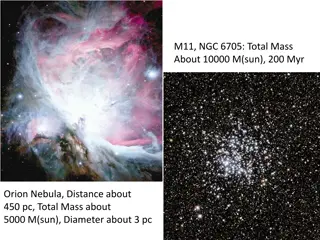Metal Distribution in Sloshing Galaxy Clusters: A Case Study of A496
Metal distribution in sloshing galaxy clusters, focusing on A496 cluster's XMM observations, cold fronts, spiral patterns, and Fe abundance across NNW cold fronts. Sloshing mechanisms in cool core clusters and the role of sloshing in redistributing metals are explored through analysis of metallicity jumps and central gas motions. The study reveals the relationship between sloshing dynamics, thermodynamics, and cluster chemical properties, shedding light on the evolution of metal behavior in the intracluster medium.
Download Presentation

Please find below an Image/Link to download the presentation.
The content on the website is provided AS IS for your information and personal use only. It may not be sold, licensed, or shared on other websites without obtaining consent from the author. Download presentation by click this link. If you encounter any issues during the download, it is possible that the publisher has removed the file from their server.
E N D
Presentation Transcript
Metal distribution in sloshing galaxy clusters: the case of A496 Simona Ghizzardi Sabrina De Grandi Silvano Molendi
Sloshing cold fronts and metals Several clusters host cold fronts. Cold fronts in cool core clusters are thought to be induced by minor mergers and to develop through a sloshing mechanism. Cold fronts and sloshing studies have focussed mainly on dynamics and thermodynamics, while the relationship between the sloshing and the cluster chemical properties has enjoyed relatively little attention. Metallicity jumps across the cold fronts have been detected for a handful of clusters. A general picture for the metal behavior during the evolution of sloshing is still missing. This is a significant limitation as sloshing may play a crucial role in redistributing metals in the ICM. CC clusters have prominent metallicity peaks at their centers. The metal distribution may trace the history of the central gas motions during the sloshing.
XMM observation of A496 We analyzed a long (120 ksec) XMM-Newton observation of A496 to study the metal distribution in this cluster and its correlation with the cold fronts and sloshing evolution. A496 is a nearby (z ~ 0.0329) bright cool core cluster. It hosts 4 cold fronts, within the central r < 250 kpc.
A496 surface brightness map The XMM surface brightness map reveals a number of discontinuities. The most prominent SB jump is at ~100 (~60 kpc) in the NNW direction (30 -120 ). 75 -120 NNW 30 -75 E In the S (240 -285 ) direction two fronts are detected S1 240 -330 - at ~55 (~35 kpc, S1) - at ~240 (~160 kpc, S2) S2 240 -285 In the E (Chandra) direction at ~ 16 kpc
Spiral patterns in sloshing A typical signature of the sloshing is the presence of spiral patterns in the clusters temperature maps. Spirals in T maps are abserved in the central regions of some cool core clusters. Simulations show that sloshing takes a spiral appearance after experiencing an off-axis merger Ascasibar & Markevitch 2006 Perseus cluster T map, Fabian + 2006
Spiral pattern in the entropy residual map can be found when a sloshing cold front is developing in a cool core. The entropy residual map shows the typical spiral-like pattern which The detected cold fronts correspond to the edge of the spiral. The outermost southern S2 cold front is placed at the tail of the spiral.
Fe abundance across NNW cold fronts We extracted the spectra in the sectors hosting cold fronts and fitted them with a vapec 1T model. The abundance drops across the NNW front similarly to what has been observed in other cool core clusters. The Fe abundance shows a decrease significant at more than 5
Fe abundance across the S2 cold front In the southern sector the Fe abundance drops across the external front. The abundance reaches the value 0.3-0.4 in the outskirts. The metallicity profile in the region within the front (50-150 kpc from the peak) is roughly constant Z ~ 0.6 before dropping at the cold front position. Zin=0.59 +0.03 0.03 Zout=0.40+0.04-0.03
Metals on the spiral To study the possible correlation between the spiral pattern and the metal distribution, we selected a number of polygons following the spiral configuration. We divided the polygons into two classes: IN (regions on the spiral) and OUT (regions outside the spiral).
Metal excess along the spiral Metals in the OUT regions follow the standard behavior of a cool core cluster. The metallicity in the IN regions shows a similar trend but is offset high. The discrepancy between the metallicity of the IN gas and of the OUT gas increases with distance: mixing processes are not very efficient. The mixing would wash out the differences.
Entropy-metallicity correlation Excluding the outskirts regions, points lying outside the spiral show a correlation between the entropy and the metallicity. The outskirts regions deviate from the correlation since the entropy continues to increase and the metallicity reaches a constant value.
Entropy-metallicity correlation Points from IN regions fall on the K-Fe relationship defined by the OUT points. The IN regions follow the same strict correlation and there is no segregation between the two classes of regions. This can be readily explained if we assume that evolution of the sloshing gas is such that neither matter nor heat is exchanged in significant quantities with gas outside the spiral.
Entropy-metallicity correlation If conduction is at work, it would rapidly transfer heat from the hotter environment to the colder sloshing gas. Effective heating would therefore move gas in the spiral away from the K-Fe correlation . Unless, heating were accompanied by dilution of the IN gas with OUT gas at just the right rate to maintain the IN points on the K-Fe correlation defined by OUT points.
Metallicity-entropy correlation If conduction and mixing are at work in the ICM, they should be adequately fine tuned to keep the points on the K-Fe correlation. Moreover, from the metallicity profiles, we can infer that mixing must be inhibited to preserve a higher metal abundance on the spiral.
Metallicity-entropy correlation The most likely and natural scenario is the one where both mixing and heat exchange are heavily suppressed. Sloshing is capable of uplifting significant amounts of gas. The limited heat exchange and mixing implies that this mechanism is not at all effective in permanently redistributing metals within the core region (the cooler metal richer gas will eventually fall back to the center).
Metallicity-entropy correlation The most likely and natural scenario is the one where both mixing and heat exchange are heavily suppressed. We also find that the conduction must be suppressed by more than one order of magnitude with respect to Spitzer conductivity otherwise the spiral-like feature would be quickly destroyed.
Summary We analyzed a long XMM observation of A496. Metal abundances drop across the cold fronts. An excess of metallicity has been detected in the regions lying on the low-entropy spiral feature. Both gas lying on the spiral and outside the spiral show a correlation between the metallicity and the entropy. There is no segregation between the polygons IN and OUT. This favors the scenario where both metal mixing and heat exchange are highly inefficient. The limited heat exchange and mixing between gas in and outside the spiral implies that this mechanism is not at all effective in permanently redistributing metals within the core region. Conduction between the gas in the spiral and the ambient medium must be suppressed by more than one order of magnitude with respect to Spitzer conductivity Sloshing provides little or no contribution to staving off catastrophic cooling in cool cores.























